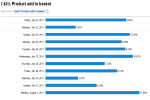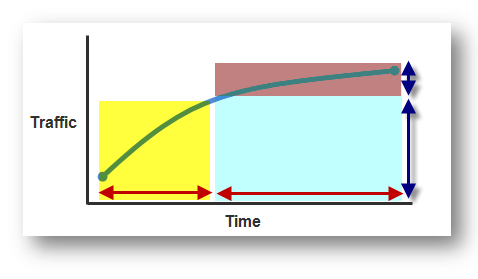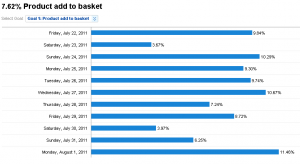 What is Conversion Rate Optimisation?
What is Conversion Rate Optimisation?
Conversion Rate Optimisation (CRO) is the process of improving the ratio of conversions to traffic on a website. For example if your website is receiving 1,000 visitors per month and 10 of them buy your product, you have a conversion rate of 1%. Using CRO, one would look to steadily improve the conversion rate, without specifically looking to develop inbound traffic.
To extend this example, if after three months your site’s traffic had naturally grown to 1,100, but the Conversion Rate Optimisation work had increased the conversion rate to 2%, then 22 people would be buying your products online each month. This would indicate that the CRO had been extremely effective.
CRO is an often neglected aspect of a digital marketing strategy. I regularly see and work with websites receiving respectable and growing amounts of traffic but still fail to convert that traffic efficiently. The temptation in SEO for some is to draw a line in the sand immediately after delivering traffic to the site. This is evident when someone comes to me after having undergone a successful SEO campaign for some time, but they still aren’t generating the business required to sustain it.
When CRO Should Happen Naturally
I think often there is a tipping point or a naturally occurring time in any campaign when shifting focus from SEO to CRO can yield more benefits than simply carrying on as before. Let me explain; often a campaign will experience the law of diminishing returns in terms of traffic. Getting to the front page of Google is really only half of the battle, the other half is getting to the top; as a result, traffic can rise quickly and then plateau for a period of time.
As the graph below illustrates, unless you are experiencing exponential growth, you are likely seeing a more linear growth in traffic over the course of a campaign. In most SEO campaigns there will be a point at which it is fair to say that you will need to spend more time than you already have to get similar levels of growth.
 It may be that you are already ranking highly for most of your major keywords and that there is little room to expand the keyword strategy. It could be that the only websites above you now are super brands loved by Google. Or it could be that the day you spend each month on your client’s retainer has stopped being enough to effectively compete against the new competition.
It may be that you are already ranking highly for most of your major keywords and that there is little room to expand the keyword strategy. It could be that the only websites above you now are super brands loved by Google. Or it could be that the day you spend each month on your client’s retainer has stopped being enough to effectively compete against the new competition.
Whatever the reason, it is at this naturally occurring point that Conversion Rate Optimisation becomes the obvious tool to continue to improve profits. More often than not website profits are influenced by two primary factors; traffic and conversions. More traffic usually translates into more conversions. However let’s offer a real world example and chuck some numbers into the mix to highlight the value of CRO.
Traffic = 10,000 visitors per month
Conversion rate = 2% (or 200 conversions per month)
Conversion value = £25
Monthly revenue = £5000
In order to increase profits you can either increase traffic to get more conversions or try to increase the rate at which you convert. Let’s say the site undergoes a CRO campaign and after four months you have increased the conversion rate from 2% to 3%, this translates into a 50% increase in conversions (or another 100 conversions per month). 100 conversions at £25 equals a welcome £2500 more revenue each month. In order to leverage the same impact on revenues as this you would have to increase traffic to the site by 5,000 in the same time frame.
CRO should be an organic progression or development to your whole strategy at some point; this is because a website will need to receive a significant amount of traffic in order to properly split test pages. If your site is delivering a couple of hundred visitors per month then it would take months and months to accrue enough data to make an informed decision as to which split tested page is working best. At least 1000 visits are required per page in order to make that kind of judgement, so once the site is experiencing volumes comparable to this CRO naturally becomes an option.
Copy the Competition
When it comes to Conversion Rate Optimisation there are basically two schools of thought on the matter; the first and most common is test first and analyse later and the second approach is to perform research before testing. Personally I prefer a third permutation of these approaches, essentially combining aspects of both methodologies into one.
By looking at what the market leaders are doing within your industry, you can start to build a picture of what is likely to work. For example looking at websites that are trying to get people to fill out a request a quote form, you will see a pattern emerging… most forms are the largest thing on the page, they stand out through use of colour or borders, they can be offset on the page and have very little text above them and the ‘submit’ button will be in a different colour to the rest of the site.
Looking at this and creating your own spin on it will be a good starting point when making changes. It is important to take into consideration that your site probably isn’t a super brand; it is not the Facebook of anything and what works for them may not work for you. For example making a social networking site for a specific industry and using Facebook style profiles and neat blue and white colours does not mean you are now the Facebook of the <insert industry>.
Research Vs Split Testing

This is the crucible where old school marketing meets digital marketing. The temptation is to start split testing straight away, follow the best practices for Conversion Rate Optimisation and start gathering all the lovely data. But there is another way; researching the needs and desires of your target audience and developing more targeted content and branding to better meet their expectations. Then bring this information, content and branding to bear in your testing process. There are an inexhaustible supply of consumer research groups who can help you understand your market better, surveys and website usability tests are also valuable methods for exploring untapped potential in your business.
There are countless examples of where a company has undergone research and identified its target audience’s tastes, reacted accordingly and seen overnight sales increases of hundreds of percent. Take Levi’s as an example back when I was young(er) they were relatively cheap and unsought-after. But once a new breed of adverts came about with NIN (Nine Inch Nails) making the soundtrack and a slick gritty video… Well the rest is history; their sales went up by something in the order of 800% if memory serves me correctly.
Even on a small scale this can kind of branding can have a substantial impact on sales. I work on a small local service based business in Southampton and after some considerable amount of research and testing I redesigned the website. This new look was more than just arbitrary colour picking, but was based on what market research had suggested and what national level companies were doing. As a result the bounce rate fell from around 50% to 20% and enquiries increased threefold over a few months of further tweaking and testing.
Best Practices
As with any of the digital marketing disciplines there are best practices, but many of these are less tangible and more flexible than SEO where guidelines are dictated largely by Google. Many improvements in conversion rate can be made simply by adhering to usability guidelines that any good website designer should know. Making the site easy to navigate, adding a logo to the top left of the page and linking it to the home page for example. Or ensuring that the site has all of the standard legal documentation such as a privacy policy and site terms can improve the sense of trust a user experiences when visiting the site.
Summary
In summary Conversion Rate Optimisation is a valuable and potentially lucrative component to any digital marketing strategy. By utilising CRO with other disciplines such as SEO, PPC, Social Media, Analytics, Branding, and Copywriting you can create an overarching holistic strategy.
Leave a Reply